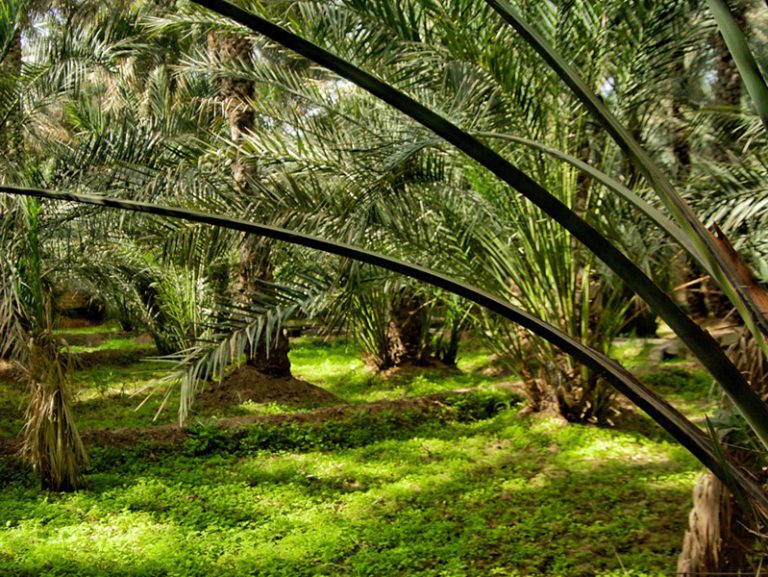Traditional oasis farming systems consist of a palm grove with fruit trees (apricot, pomegranate, etc.), vegetable and/ or fodder crops growing in the understorey thereby forming a rich yet endangered oasis of agrobiodiversity.
This agroforestry-based three-storied cropping system accounts for the so-called ‘oasis effect’, i.e. creation of a microclimate conducive to agriculture. Date palms filter sunlight, while serving as a windbreak for the understorey crops and helping maintain soil moisture, which in turn reduces the air temperature. This multistoried cropping system also enhances the root distribution in the soil as well as plant uptake of available resources, including water. Ecologically intensive oasis agriculture is often associated with extensive livestock farming on vast rangelands—a combined mixed cropping- livestock farming system that enhances soil fertility. From the outset, oasis systems are intimately based on agrobiodiversity. Oases therefore have a diversified agricultural heritage. Morocco, for instance, hosts 453 date palm cultivars and over 2,300 natural hybrids, Tunisia has over 250 cultivars (Institut national de la recherche agronomique, Atlas du palmier dattier au Maroc, 2011) and Mauritania 162 cultivars (Ministry of Environment and Sustainable Development of Mauritania, Sixième rapport national à la Convention sur la diversité biologique, 2018).
Food security and resilience to hazards
Oasis agriculture is based on family farms that practice intercropping. This system generates sufficient yields to meet the food needs of local communities while ensuring that people have a diversified balanced diet. The food security of people living in oasis areas—as well as country-wide—is thereby enhanced. The vulnerability of these oasis farms to uncertain climatic/economic conditions is reduced through the associated agrobiodiversityfriendly practices. Oasis systems are also thereby less vulnerable to diseases.
Source of income and economic activity
The cultivation of a diverse range of crops in oases creates economic opportunities. Certain high added value aromatic, medicinal or tinctorial plants, such as henna, may be grown in the oasis understorey. The date-growing sector represents, for instance, 50% of the agricultural income of 2 million Moroccans3. In addition to the food benefits, the many date palm by-products (waste, date vinegar, etc.) are also of potential commercial value and could generate jobs and income. Temporal staggering of crop harvests enables farmers to earn supplementary income while providing their families with a regular source of nutritious food throughout the year. Oases are generally habitable sites with a very low population density (less than 1 inhabitant/km2) where communities can readily settle to take advantage of the promising economic opportunities. Activities related to the agricultural sector (processing, marketing, etc.) are still generally not highly developed—in most cases the oasis is merely a site of production. Enhancing biodiversity could potentially help generate jobs: processing and marketing of agricultural products, tourism, etc.
Oasis biodiversity to tackle major challenges of the century
Oases have been thriving/surviving for over 2,000 years thanks to their ability to cope with scarce resources, which explains their high resilience capacity. Over the centuries, communities living in oases have managed to develop biodiversity adapted to the prevailing climatic conditions—a gene pool of local species that is essential for climate change adaptation. Oases represent an invaluable reservoir of know-how and knowledge on the adaptation of life in dryland areas that could be tapped to enhance the management of arid environments and foster interplay between human activity and the environment, while ensuring natural resource preservation and renewal. These habitats play a key role in spatial structuring, offer essential environmental services and could serve as ecological networks and protected areas. In drylands, oases offer a favourable habitat for wildlife biodiversity, particularly birds.
Transforming oases into palm groves – a poor compromise
The oasis economy is based mainly on date palm growing, which is essential in many dryland regions. The promotion and improvement of date varieties and their qualities is a development challenge. The traditional oasis system is no longer the sole flagship model. An oasis often includes the former palm grove, small family farms on the fringes and large modern palm crop plantations. The latter system—fostered by the capitalization of agriculture advocated by the agricultural development policies of the 1960s (RADDO, Un exemple de préservation de la biodiversité dans les oasis du Djerid, 2011.) jeopardizes oasis sustainability and prompts changes in the sociotechnical organization of oases.
Threats to the oasis agriculture and economy
The transformation of threestoried oasis cropping systems into date palm monocultures generally leads to a loss of genetic diversity due to a reduction in the number of cultivated species. The elimination of food crops also boosts people’s dependence on external food procurement.
Commercial dependence on the date market alone is perilous for the oasis economy, which could collapse in the event of a poor date harvest.
Monoculture farming also increases palm susceptibility to diseases and the pace of their systematic spreading. In Morocco, within less than a century, Bayoud disease (Bayoud is a vascular disease caused by Fusarium oxysporum f. sp. albedinis, a microscopic soil fungus that spreads throughout the palm grove via a ripple effect.)has reduced the national date palm population from 12 to 4.8 million palms. Varieties for export are particularly susceptible and intensively cultivated palm groves are the most endangered. These different factors increase the risk of excessive economic dependence on the date palm commodity market in oasis areas.
Endangered water resources
Date palm trees consume high volumes of water (around 20,000 m3 / ha). Meanwhile, roughly 60% of the population in North Africa is considered to be ‘water poor’, i.e. 500 m3/year/capita of water available on average, which is well below the water poverty line set by the United Nations (1,000 m3/year/capita). Palm crop intensification in oases can thus have devastating effects in this region, while the Intergovernmental Panel on Climate Change also forecasts that rainfall levels will fall by 2050. The emergence of these modern palm groves is resulting in the extraction of fossil non- or barely-renewable groundwater resources. The increase in the surface area of this type of palm grove—associated with rising urbanization and the increased concomitant water needs—is leading to recurrent water conflicts and ultimately to the depletion of groundwater reserves.
Ecological impact
The disappearance of traditional three-storied oasis agricultural systems is neutralizing the ‘oasis effect’ as well as the microclimatic conditions that maintain humidity and reduce temperatures. Moreover, date palm diseases are now mainly being systematically controlled via chemical treatments. In the long term and as a result of climate change, increased temperatures, extreme weather events (floods, fires, droughts) and pollution will result in increasingly massive destruction of oasis environments.
Oasis recommendations
• Mainstream oasis issues in all sectoral policies in concerned countries.
• Adopt a participatory natural resource management strategy involving local communities.
• Promote existing and innovative agroecological practices.
• Set up systems to safeguard species (in situ conservation by local communities).
• Identify and develop “strategic crops” acclimatized to desert regions.
• Facilitate oasis organic waste recycling (palm fronds, etc.) to preserve soil fertility.
• Develop sustainable energy production.
• Incorporate oasis production in value chains and marketing channels.
For further information :
• Jouve P., 2012. Les oasis du Maghreb, des agroécosystèmes de plus en plus menacés. Comment renforcer leur durabilité ?
• Réseau associatif de développement durable des oasis (RADDO): www.raddo.org
• Centre d’actions et de réalisations internationales (CARI): www.cariassociation.org
• LabOasis Foundation: www.laboasis.org


